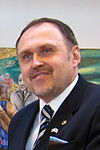Yukon general election, 2011
|
|
|||||||||||||||||||||||||||||||||||||||||||||||||||||
|---|---|---|---|---|---|---|---|---|---|---|---|---|---|---|---|---|---|---|---|---|---|---|---|---|---|---|---|---|---|---|---|---|---|---|---|---|---|---|---|---|---|---|---|---|---|---|---|---|---|---|---|---|---|
|
|||||||||||||||||||||||||||||||||||||||||||||||||||||
|
|
|||||||||||||||||||||||||||||||||||||||||||||||||||||
|
All to the Legislative Assembly 10 seats needed for a majority |
|||||||||||||||||||||||||||||||||||||||||||||||||||||
| Opinion polls | |||||||||||||||||||||||||||||||||||||||||||||||||||||
| Turnout | 74.3% | ||||||||||||||||||||||||||||||||||||||||||||||||||||
|
|||||||||||||||||||||||||||||||||||||||||||||||||||||

Popular vote by riding. As this is an FPTP election, seat totals are not determined by popular vote, but instead via results by each riding.
|
|||||||||||||||||||||||||||||||||||||||||||||||||||||
|
|||||||||||||||||||||||||||||||||||||||||||||||||||||
The 37th general election in Yukon, Canada, took place on October 11, 2011, to return members to the 33rd Yukon Legislative Assembly.
The incumbent government was led by Darrell Pasloski, who was elected as leader of the Yukon Party at a convention on May 28, 2011, replacing former Premier Dennis Fentie. The Yukon Party won its third majority government from the voters. Elizabeth Hanson's New Democrats became the Official Opposition, replacing the Liberals, whose leader, Arthur Mitchell was unable to return to the Assembly.
In 2008, the Yukon Assembly struck a committee to review the electoral district boundaries for this election. The committee decided to increase the number of seats in the territory to 19. Yukon now matches the other territorial assemblies in the Northwest Territories and Nunavut in terms of the number of seats.
The rural districts outside of the capital city of Whitehorse remained unchanged with the exception of Mount Lorne and Southern Lakes which were merged into a single district. The total number of rural districts dropped from 9 to 8.
The urban ridings in Whitehorse were increased to 11 from 9. Only three districts in Whitehorse had no boundary changes, Whitehorse Centre, Riverdale North and Riverdale South. The riding that received the most significant alteration was Copperbelt. That district was split into four ridings, primarily Copperbelt North and Copperbelt South, while McIntyre-Takhini was significantly expanded in western uninhabited part of Copperbelt and renamed Takhini-Kopper King. An entirely new riding was also created out of Copperbelt called Mountainview. The remaining urban districts all received minor boundary adjustments.
...
Wikipedia


